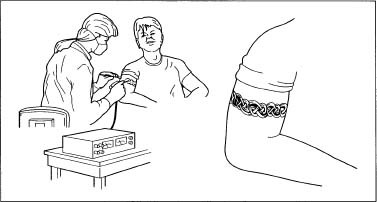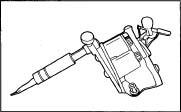Tattoo
Background
A tattoo is a design that is permanently etched in the skin using needles and ink. The word tattoo is derived from the Tahitian term "tatua," which means "to mark." Tattoos have been displayed by people of all cultures for centuries, but they have only recently gained social acceptance in the United States.
History
Adding decorative illustrations to skin has been a popular practice since ancient times. Clay dolls have been found that indicate the Egyptians used tattoos as early as 4000 B.C. Over the centuries, different forms of tattoo art have been practiced by many different world cultures. For example, around 500 B.C. , the Japanese began tattooing for both cosmetic and religious purposes. They even used tattoos to brand known criminals as part of their punishment. The Japanese method involved puncturing the skin with fine metal needles to create multicolor designs. Eskimos tribes developed their own technique using bone needles to pull soot-covered thread through the skin.
In the 1700s, Captain James Cook traveled to Tahitia and observed the natives' skin marking customs. In his book The Voyage in H.M. Bark Endeavor, Cook wrote, "they stain their bodies by indentings, or pricking the skin with small instruments made of bone, cut into short teeth; which indentings they fill up with dark-blue or black mixture prepared from the smoke of an oily nut. This operation, which is called by the natives 'tatua' leaves an indelible mark on the skin." In the years after Cook's voyages, sailors visiting the Polynesian islands spread the Tahitian ritual around the Pacific.
The popularity of tattoos continued to grow over the last 200 years. In the nineteenth century, tattoos became popular in England among the upper-class. For example, Lady Randolph Churchill, Winston Churchill's mother, had a snake tattooed around her wrist. In the United States, tattoos have been historically associated with sailors, motorcyclists, and prison inmates because tattoo shops were considered dangerous and socially unacceptable. However, since the 1980s this mindset has changed considerably and tattoos are becoming increasingly popular among men and women of all ages.
Design
A tattoo design is called "flash" and it can consist of any sort of artwork from simple symbols or letters to detailed sketches or caricature. Flash can be composed of one color or many. Tattoo parlors display a large assortment of flash on their walls with the larger ones having as many as 10,000 to choose from. In addition, clients may bring in their own design or they may work with the artist to develop custom flash.
When selecting a design it is important to consult with the artist to establish an appropriate size and location for the tattoo. The artist can also help decide on color schemes that will determine the price of the final art. Care should also be taken to identify a reputable tattoo parlor that follows the guidelines set forth by the Association of Professional Tattooists (APT). According to the APT, the tattooists should follow these precautionary measures: have the client fill out consent forms before beginning the procedure; wash and dry their hands immediately before and after working on the customer;

Raw Materials and
Equipment
Flash
The flash, or tattoo design, is simply a sketch or a piece of line art that can be used to create a tattoo. Flash may be shown in color or in black and white and they are displayed in the tattoo parlor either in books or along the walls.
Stencil
A stencil is a copy of a flash that is made on a special copying machine. The stencil allows the inked outline of the design to be transferred to the skin so it can be traced by the artist.
Ink
Tattoo supply houses sell special inks that are used to create tattoos. They are available in a variety of colors and are typically packaged in 4 oz plastic squeeze bottles so they are easily dispensed. These inks are liquid dispersions of pigments that, in the United States, are approved by the Food and Drug Administration. The ink consists of dyes derived from metal components. For this reason, allergic reactions to the type of ink used is possible.
Tattoo Machine
The machine consists of a hand held needle gun connected to a power unit that provides pressure to move the needles. The needles may be of different sizes and shapes and are bundled together on a needle bar in different patterns depending on the requirements of the artwork. The unit is attached to a power supply that is activated by depressing a foot pedal on the floor beside the work station. When the pedal is depressed the tattoo needle bar moves up and down very quickly like the needle on a tiny sewing machine. It penetrates the skin to inject the dye 3,000 times per minute.
Miscellaneous supplies
During the course of the procedure the artist may use a variety of additional supplies including skin disinfectants, disposable razors, bandages, petroleum jelly, and biocidal cleaning supplies.
The Manufacturing
Process
-
Before the process can begin, the artist should have the client sign a
waiver that indicates they are over 18, understand the procedure is
permanent, and realize it will create an open wound or abrasion. After
the waiver is signed, the tattooist inspects the skin to ensure it is
free from cuts and
scrapes. He or she then sprays the skin with an antiseptic to kill germs and reduce the possibility of infection. The artist then shaves the area and disposes of the razor immediately afterward.
 The tattoo machine.
The tattoo machine. - When the skin is ready, the artist prepares the design to be copied onto the skin. This is done using a copy machine to make a color copy of the flash that is the proper size. The copier uses a special carbon-type paper that allows the design to be transferred to skin. The client exposes the target area and the artist peels the design off the backing paper and applies it to the proper location. This creates an ink outline of the design on the skin that is used to guide the artist in creating the actual tattoo. The client must be careful not to touch the outline or to otherwise disturb the skin because the stencil can be accidentally smeared. At this point, the client can look at the design (in a mirror if necessary) to confirm it is correct. If there is something wrong with the stencil it can be washed off and applied again. Once the stencil is completed, the tattooist spreads a thin layer of ointment, such as petroleum jelly, over the area to be tattooed.
- The artist directs the client to sit or lay in 3 a position that exposes the skin to be tattooed. The client may recline in a dentist-type chair that can lay flat to aid in exposing the back or buttocks. The position must be comfortable for the client but must also provide a comfortable working position for the artist who typically sits on a stool next to the client's chair.
- Next, the artist prepares the tattoo inks on a pallet, which is a plastic tray with a series of divots to hold the ink. The artist fills several of these wells with ink; black is typically used for the outline color. He or she then attaches a needle bar with three to five needles to the tattoo machine. The needles are dipped into the ink well to suck up the colorant and the artist then activates the needle gun with the foot pedal and begins to trace the stencil. Because the needles are breaking the skin for the first time in this step, it is a very painful process. The needles deposit the dye in the second layer of the skin which is about 0.64-0.16 in (1.6-0.4 cm) deep. This process may take five minutes to an hour depending on the size and complexity of the design. The skin may be slightly numb by the time outlining is complete.
- After the stencil is outlined the artist fills the ink wells with the colors to be used to finish the tattoo. He or she then connects a shader needle bar to the tattoo machine. This shader bar may contain five to thirteen flat needles or five to seven round needles. It is designed to apply color over a larger area to fill in the outline. The tattooist guides the tattooing machine over the skin coloring in all sections of the outline. He or she frequently stops the needle to wipe the blood and ink off the skin. The amount of bleeding caused by the needle penetration and the degree of pain experienced varies from person to person. The shading operation may take an hour or several hours depending on the complexity and size of the design. Shading is complete when the entire surface of the tattoo has colored in.
Quality Control
The key to ensuring a successful tattoo is taking care of it properly in the first few hours and days. Immediately after the tattoo is finished, the area is washed with a mild soap solution and then covered with an antibiotic ointment and a gauze bandage. After allowing the area to heal for about two hours, a bandage should be removed so dried blood can be washed away. For the first week, apply a vitamin lotion to the area daily. After that, apply a regular, mild skin lotion to keep the tattooed area moist until the wound has finished healing. The affected area should be kept out of hot tubs, swimming pools, and hot baths until the skin has healed fully. Submersion in water too soon can ruin the tattoo.
In general, taking care of the tattoo is like treating a minor burn. It must be kept clean and moist, and will experience the same sort of scabbing and crusting. The initial healing process usually takes about two weeks.
Tattoo Removal
It is not uncommon for someone to change their mind after a period of time and to want to have their tattoo removed. Tattoo removal is possible but the process is difficult, expensive, and not fully successful. In the past, a wire brush was used to sand the skin and destroy the first and second layers where the ink resided. Salt solutions were also used to leach out the ink or acid was used to burn the skin away.
All of these methods are painful and not very effective. Even if the tattoo can be removed, the affected area may lose its ability to produce normal skin pigment and some scarring may occur. Recently, lasers have been used to remove tattoos because they can destroy most of the ink pigments and cause very little scarring. Still, the process is expensive and the skin may never produce its normal pigmentation again.
The Future
Tattoos continue to grow in popularity as a method of self expression. It is also anticipated that tattoos will be used increasingly for medical and non-medical cosmetic applications. For example, tattoos can be used to obscure the reddish purple birthmarks known as "port-wine" stains. They may also be used to improve the skin color of patients with vitaligo, a disorder that causes the melanocytes in the skin to shut down and stop producing normal skin color. Tattooing is also being used to create permanent makeup, such as eye liner or blush, for burned or disfigured victims.
Where to Learn More
Books
Graves, Bonnie. Tattooing and Body Piercing. Capstone Press, 2000.
Wilkonson, Beth. The Dangers of Tattooing, Body Piercing, and Branding. Rosen Publishing Group, 1998.
Other
Tat2studio.com Web Page. December 2001. < http://www.tat2studios.com >.
Randy Schueller